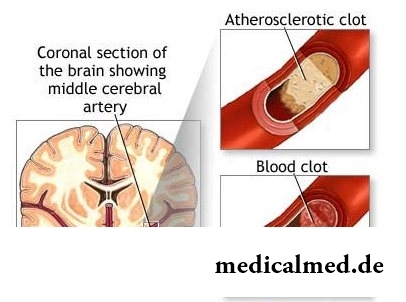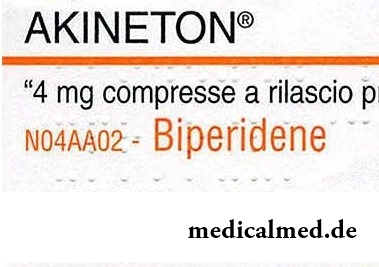





Parkinsonism
General characteristic of a disease

Parkinsonism is a neurologic syndrome which main symptom is disturbance of autokinesias. The syndrome of parkinsonism meets at a number of neurologic diseases and is always followed by trembling of extremities, constraint of muscles, and also slowness of movements of different degree of manifestation.
Depending on an etiology of a disease distinguish primary or idiopathic parkinsonism and a secondary or symptomatic form of a syndrome of parkinsonism. In the first case the disease is caused by gradual death of dopamine neurons in the central nervous system of the person. They are responsible for braking of a physical activity, and their deficit leads to disorder of motive function of an organism.
The secondary syndrome of parkinsonism is provoked by external factors: medicines, craniocereberal injuries, infections, etc.
Parkinsonism – one of the most widespread diseases of people of advanced age. It was described for the first time in 1817 and called in honor of J. Parkinson. After 80 years the syndrome of parkinsonism is diagnosed approximately for every 5th inhabitant of the planet. Increase in life expectancy of people in the developed countries leads to the further statistical growth of number of patients with parkinsonism.
Parkinsonism symptoms
Tremor, it involuntary trembling of extremities – one of the brightest symptoms of parkinsonism. During autokinesia the tremor disappears and appears again at motive passivity of the patient.
One more important symptom of parkinsonism – rigidity, it is constraint of muscles. The disease is shown by the raised muscle tone of skeletal muscles. Because of it performance of any movement demands application of additional efforts. Muscle tension is followed by stoop. There is even an informal name for the patient's pose with parkinsonism syndrome – the "pose of the applicant" caused by change of the reflexes which are responsible for vertical position of position of a body.
As additional symptoms of parkinsonism are considered олиго - and a bradykinesia (slowness and deficit of movements), depletion of gesticulation and a mimicry, balance disturbance.
Primary parkinsonism at elderly people can lead to disturbances of salivation, swallowing, monotony of a voice and in rare instances to dementia (weak-mindedness). The last called parkinsonism symptoms usually are demonstrated at a late stage of a disease.
All symptom complex of a disease results in difficulties when performing everyday occupations, gives a considerable inconvenience and disappears only during sleep the patient.
Types of parkinsonism
According to the standard classification of a disease allocate vascular parkinsonism, and also toxic, medicinal, posttraumatic and postencephalitic types of a disease.
Vascular parkinsonism is provoked by vascular pathologies. Unlike other types of a disease at it the patient has no periods of lack of a tremor. Involuntary trembling of muscles at vascular parkinsonism is provoked by subacute or acute disorders of cerebral circulation. In case of an aggravation of symptoms the disease can develop into a stroke.
Vascular parkinsonism – one of the most rare forms of a disease. Much toxic and medicinal types of a disease meet more often.
Toxic parkinsonism arises against the background of chronic or acute poisoning with heavy metals, poisonous gases or drugs.
Medicinal parkinsonism provokes reception of medicines, for example, of neuroleptics.
Posttraumatic parkinsonism is caused by damages of structures of a brain and occurs most often at boxers. One their subspecies of parkinsonism - Martland's syndrome which is characterized by dystrophic changes of a brain.
Postencephalitic parkinsonism has an infectious etiology. It develops because of damages of an upper brainstem at epidemic encephalitis. One of symptoms of parkinsonism of this look - oculomotor frustration: involuntary rolling of eyes, etc.
Diagnosis of parkinsonism
The tremor and other disturbances of a physical activity are shown already at death of a significant amount of motor neurons. At this stage of a disease diagnosis does not cause difficulties any more. Though not one of symptoms of parkinsonism is not the pathognomonic sign typical only for this disease. Therefore the final diagnosis is established only after long observation of the patient and improvement of its state under the influence of holinoblokator.
Earlier diagnosis of parkinsonism is based on fixing of the minimum changes in a voice of the patient caused by disturbances of functions of muscles of a throat.
Treatment of parkinsonism

The scheme of treatment of parkinsonism is especially individual for each patient. For stopping of a syndrome of a medicinal look there is usually enough cancellation of a course of the accepted medicines. Treatment of parkinsonism of vascular type assumes surgical correction of cerebral circulation by a shunting method.
Part of obligatory drug treatment of parkinsonism of any kind is purpose of L-DOFA-preparatov, cholinolytics, etc. Drug treatment of parkinsonism helps to reduce only manifestation of symptoms of a disease and to slow down its progressing.
Therapy of parkinsonism lifelong therefore development of side effects is possible: locks, dryness in a mouth, the general weakness, disturbance of a cordial rhythm, a dysmnesia and so forth. At insufficient efficiency of conservative treatment of parkinsonism will be applied neurostimulation of a brain. For this purpose under the patient's skin in a breast the neurostimulator which is connected by electrodes to a brain is implanted.
Refer also electroconvulsive therapy, deep stimulation of a brain to radical methods of treatment of parkinsonism of heavy degree magnetic field, and also change of stem cells and embryonal fabrics to the patient.
The 74-year-old resident of Australia James Harrison became blood donor about 1000 times. It has a rare blood group which antibodies help to survive the newborn with a severe form of anemia. Thus, the Australian saved about two million children.

The drugs stopping or oppressing life activity of pathogenic microorganisms are widely applied in clinical practice with 4...
Section: Articles about health
EKO, or extracorporal fertilization - a method of treatment of infertility which became the reason of a set of broken-down copies in due time accused the people working on its creation neither more nor less of rivalry good luck. Already very few people deny the rights...
Section: Articles about health
The winter swimming in open reservoirs called in our country by "winter swimming" – officially recognized sport and one of the most extreme ways of a hardening of an organism. This occupation has an old story and adherents in many countries. The international competitions in winter heats on open water, and every two years – the World Cup are annually held. Despite huge popularity and the proved advantage for health, winter swimming is still surrounded with hardy delusions. Ра...
Section: Articles about health
The pancreas performs two functions in a human body: release of enzymes without which digestion carbohydrate is impossible...
Section: Articles about health
Partial and the more so full loss of hearing significantly reduces quality of life. Difficulties with communication lead to loneliness and isolation. The person who badly hears experiences difficulties with social and professional implementation, quite often has problems in...
Section: Articles about health
The summer of this year in Russia was very ambiguous. Regions suffered from a merciless heat, from pouring rains, the hail from time to time dropped out, then there was again a heat which alternated with rainfall again. Many people suffer from such sharp changes of weather. Even flu epidemics and a SARS were recorded....
Section: Articles about health
Heart disease and blood vessels lead to disturbance of blood supply of bodies and fabrics that involves failures in their works...
Section: Articles about health
For anybody not a secret that our country is one of the most "drinking" in the world. At clear understanding that the use of hard alcoholic drinks – occupation extremely harmful, most of Russians belong to alcoholism with unjustified loyalty. These...
Section: Articles about health
Energy saving lamps are one of the most popular products of innovative technologies, and there is no wonder: they much more economic also are more long-lasting than usual filament lamps. At the same time there are fears that energy saving bulbs can become the reason of emergence of problems with health. Unfortunately, some of similar opinions have the real reasons....
Section: Articles about health
Musicotherapy – a treatment method which caused and causes a set of a controversy concerning its efficiency. However the facts are relentless:...
Section: Articles about health
Wood louse – the ordinary-looking unpretentious plant extended in all territory of our country. It quickly expands, and sometimes fills sites, bringing a lot of chagrin to gardeners. Perhaps, they would be upset less if knew that the wood louse is the prices...
Section: Articles about health
Doctors claim that the people not so familiar with a dorsodynia occur among adult Russians very seldom. At the same time the vast majority of the patients who are periodically testing this indisposition do not hurry to ask for medical care at all. On the one hand, there is an opinion that feelings of this sort at mature age are nearly natural phenomenon which is not doing serious harm to health. With another – practice of self-treatment various obezbol is eurysynusic...
Section: Articles about health
Let's begin with the fact that a separate illness which is called "adjournment of salts", just does not exist. In practice this household name of plank beds...
Section: Articles about health
Practically each person is familiar with the annoying, pulling, unscrewing pains caused by overcooling of muscles of a back. In certain cases inflammatory process is not limited to discomfort, being followed by emergence of hypostasis, consolidations, increase температ...
Section: Articles about health
Neurosis is called pathology of a nervous system at which deviations in functioning of the highest nervous processes are observed. Most often - owing to yet not strengthened mentality - children are subject to neurosises. The unhealthy, hostile atmosphere in collective, a family, the strong and sharp shock, and also a set of other factors which negatively influence the little person who did not learn to overcome stresses yet can become premises to emergence of such disturbances....
Section: Articles about health
Helminthosis is one of the most widespread diseases. Statistically, with any species of helminths it is infected porridges...
Section: Articles about health
Childbirth is the most important event in life of each woman. We are women we give birth to the new little man on this light. Now the tendency to that was outlined, as men want to participate in labor too. But there is a question and whether it is worth allowing the husband...
Section: Articles about health
An eye of the person daily experiences considerable strain. The problem of preservation of sight is for many years directly connected with a question of supply of tissues of eye enough oxygen and nutrients. This task is carried out by small vessels – capillaries. For normal functioning of the visual device extremely important that they kept the integrity, but it works well not always. Microtraumas of eye vessels during which there are small hemorrhages it is extraordinary расп...
Section: Articles about health
It would seem, to buy drugs in Moscow does not make a problem – a drugstore, and not one, is available for each resident of the capital in step a toast...
Section: Articles about health
Smack in a mouth can arise in the natural way – as a result of lack of morning hygiene or reception of the corresponding food. However in certain cases its existence is a sign of certain pathologies, and allows to reveal an illness at an early stage. In we depend...
Section: Articles about health
Olive oil – the product capable to make a powerful contribution to health of the person if it includes it in the diet. The rich vitamin composition of oil does it by a product number one from many diseases including from deadly. Only two tablespoons of oil from olives in day prevent emergence of diseases of vessels and heart, cancer, problems with digestion, presenilation, a depression and many other illnesses which treatment would demand a lot of time and forces. Let's consider on...
Section: Articles about health
Dark circles (bruises) under eyes – a shortcoming with most of which often fight against the help of cosmetics (proofreaders, salons...
Section: Articles about health
Producers of milk mixes for children assure: mixes are ideally balanced and adapted for needs of babies. If mother should raise artificially the kid owing to serious problems with health, to do nothing – m substitutes...
Section: Articles about health
The concept "gluten" (differently, a gluten) combines group of the proteins which are a part of rye, barley and wheat. For most of people the use of the food stuffs containing a gluten not only is safe, but also it is very useful. Nevertheless, there is a number of myths about negative effect which allegedly gluten has on health of the person....
Section: Articles about health
Each person knows that fervescence is an illness sign. However about existence of diseases can to suite...
Section: Articles about health
Scientists have no unambiguous opinion on a proximate cause of emergence of a carcinoma cutaneum today. Only the factors promoting development of this illness are precisely established. Treat them: long impact on skin of ultraviolet rays, radioactive...
Section: Articles about health
It is known that the person for 80% consists of water which participates in all processes of an organism. The person loses liquid daily – as a result of sweating, breath, an urination, and its insufficient completion due to various reasons can lead to dehydration of varying severity. Dehydration (dehydration) occurs already in case of loss of liquid in number of 1% of body weight and can result both in easy thirst, and by the death. In time to notice signs обезвож...
Section: Articles about health
